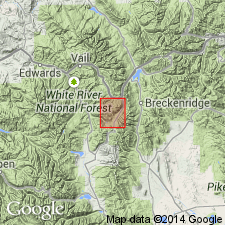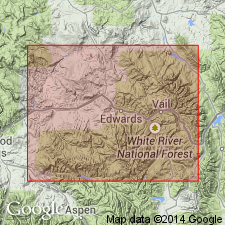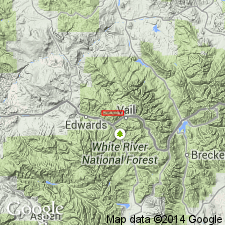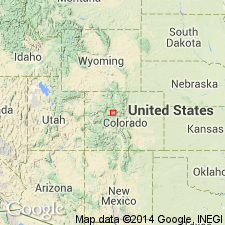
- Usage in publication:
-
- Jacque Mountain limestone*
- Modifications:
-
- Original reference
- Dominant lithology:
-
- Limestone
- AAPG geologic province:
-
- Eagle basin
Summary:
Jacque Mountain limestone member of Maroon formation. Light bluish gray limestone, characterized by an oolitic structure in certain layers. Top member of Maroon formation. Conformably overlain by Wyoming formation. [Map shows upper part of Maroon formation exposed on lower slopes of Jacque Mountain and Jacque Ridge, and that upper part of Jacque Gulch is cut in upper part of the Maroon.] Age is Permian.
[GNC remark (ca. 1938, US geologic names lexicon, USGS Bull. 896, p. 1038): The present approved definition of Maroon formation is for the beds above the †Weber grits and below Morrison formation, including the beds called "Wyoming formation" by Emmons at the time he defined Jacque Mountain limestone. The Jacque Mountain limestone is not, therefore, the top member of Maroon formation, but occurs near the middle of the Maroon as now recognized.]
Source: US geologic names lexicon (USGS Bull. 896, p. 1038).

- Usage in publication:
-
- Jacque Mountain limestone member
- Modifications:
-
- Revised
- AAPG geologic province:
-
- Eagle basin
Summary:
Pg. 1376 (fig. 1), 1378 (fig. 2), 1379-1380, 1389. Jacque Mountain limestone member of Battle Mountain formation (new). Reallocated to member status in Battle Mountain formation. [Consists of light-gray, oolitic, fossiliferous limestone and breccia. Thickness 18 feet at type Battle Mountain, Eagle County, western central Colorado.] Overlies Robinson limestone member; lies near top of formation, about 120 feet below State Bridge formation (new). Thickness about 30 feet; locally splits into two limestone beds 100 feet apart. [Age is Pennsylvanian.]
Source: US geologic names lexicon (USGS Bull. 1200, p. 1906-1907); supplemental information from GNU records (USGS DDS-6; Denver GNULEX).

- Usage in publication:
-
- Jacque Mountain limestone member*
- Modifications:
-
- Revised
- AAPG geologic province:
-
- Eagle basin
Summary:
Pg. 152 (table 1), 204-205, 207-208. Jacque Mountain limestone member of Minturn formation. Reallocated to member status in Minturn formation. Overlies White Quail limestone member; top of member marks top of Minturn as here defined. Typically 15 to 25 feet of dark-bluish to light-gray, fine-grained limestone, some parts of which are characteristically oolitic. Fossils. Contains cephalopods and gastropods that might be either Pennsylvanian or Permian, but evidence slightly favors Pennsylvanian age.
Source: US geologic names lexicon (USGS Bull. 1200, p. 1906-1907).

- Usage in publication:
-
- Jacque Mountain Limestone Member*
- Modifications:
-
- Age modified
- AAPG geologic province:
-
- Eagle basin
Summary:
As the uppermost member of the Minturn Formation is a critical unit used for separating the Minturn Formation of Des Moines or younger age from the Maroon Formation of Pennsylvanian and Permian age. Tongues westward in Eagle basin into Eagle Valley Evaporite (a new unit).
Source: GNU records (USGS DDS-6; Denver GNULEX).

- Usage in publication:
-
- Jacque Mountain Limestone Member*
- Modifications:
-
- Revised
- AAPG geologic province:
-
- Eagle basin
Summary:
Can be traced west in six measured sections from type Minturn Formation to Avon, Eagle Co, CO and across Wolcott syncline where name Eagle Valley Evaporite is used. Is assigned to Eagle Valley as a member--Jacque Mountain Limestone Member--in area from Avon west. Some place the top of the Eagle Valley at the top of Jacque Mountain, but this author places the upper Eagle Valley contact much higher at the top of the uppermost gypsum. Overlies and underlies unnamed clastic sequences of Eagle Valley. Is of Middle Pennsylvanian age.
Source: GNU records (USGS DDS-6; Denver GNULEX).
For more information, please contact Nancy Stamm, Geologic Names Committee Secretary.
Asterisk (*) indicates published by U.S. Geological Survey authors.
"No current usage" (†) implies that a name has been abandoned or has fallen into disuse. Former usage and, if known, replacement name given in parentheses ( ).
Slash (/) indicates name conflicts with nomenclatural guidelines (CSN, 1933; ACSN, 1961, 1970; NACSN, 1983, 2005, 2021). May be explained within brackets ([ ]).

